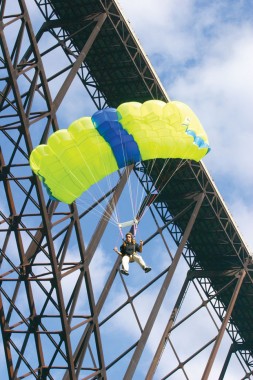Free Fallin’, BASE jumpers highlight Bridge Day in the Gorge.
In October of 1980, something incredible happened in West Virginia. Five men donning parachutes walked to the edge of the newly constructed 876-foot-tall New River Gorge Bridge. With policemen, Park Service, and safety professionals looking on in approval, they stepped into oblivion.
From these humble beginnings, Bridge Day has grown to over 800 jumps per year and 100,000+ spectators who all come to participate in a celebration of the sport, spectacular fall scenery, and the local community. Although originally started as a way for the general public to walk on the bridge, BASE jumping has taken center stage.
Jumpers plunge from diving boards and platforms on the side of the bridge and land in the Fayette Station river access area far below. Safety boats patrol the waters, and spectators can view the whole show from the bridge itself, trails along the rim, or the National Park observation deck at the New River Gorge Visitor Center. It remains one of the most popular legal options for BASE jumping in the U.S., and it shines as an example of how fringe sport enthusiasts and authorities can work together towards a mutually beneficial solution.
Summersville local jumper Marcus Ellison has witnessed the spectacle many times since he was a child. There was something about watching people submit to the forces of gravity that resonated with him. At the age of 23, Ellison began skydiving with the intention of moving to the BASE side of the sport. Before he knew it, Bridge Day 2008 had arrived, and he was standing on a platform looking over the chasm with friends and family watching. It was his turn to jump.
“It’s a moment of clarity and relaxation,” Ellison explains. “When your feet disconnect from what you are on, there is an unbelievable feeling of release and freedom. That is what I’m after: that instant when you disconnect.”
Marcus has disconnected across the country, and has over 300 skydives and nearly 200 BASE jumps to his name. He is drawn to the sport for many reasons, but in no small part because of the dramatic places that it brings him to. His favorite jumps are in massive alpine environments, and are sometimes combined with skiing. This focus on the beauty of the surroundings makes BASE jumping a soulful sport that is more similar to other outdoors pursuits than many think. It doesn’t require the manpower, airline fuel, and permits that skydiving does, and it is almost always a quiet, under-the-radar activity with just a friend or two. Due to the infancy of the sport, the rules of BASE are still being written.
Bridge Day is hardly a normal day for these jumpers. In spite of the fanfare, lines, and spectators, it is often the only opportunity every year to reconnect with friends from across the planet. It’s a perfect chance for first-time jumpers to meet and learn from the legends of the sport. Personalities like Red Bull athlete Miles Daisher, oil rig lifestyler Chris McDougall, and wildman Jeb Corliss can be seen in the lineup, and are quick to give high fives and trade stories with aspiring young athletes.
Jason Bell, BASE Coordinator for Bridge Day, says that it is without a doubt the best day for skydivers to make their first BASE jump. “We have over 100 first-timers every year, and due to setting, the system that we have developed, and the safety measures in place, it is a perfect way to get into the sport.”
Rookies feel confident at Bridge Day for several reasons. First of all, it is the third tallest bridge in the U.S., and the more time that jumpers have to deal with the unexpected, the better. Jumping from a bridge also eliminates the danger of colliding with a cliff or other standing structures should the jumper spin and open the chute the wrong way. The primary landing area is a deep river, and rescue boats are constantly fishing jumpers out of the water. Finally, there are ambulances and other safety personnel and technology at the bottom, ready to deal with injury. On the logistical side, Bell and his team vet applicants through interview questions, and there are two gear checks for all jumpers before they are allowed to queue up for freefall.
While it’s appealing to beginners, advanced athletes can also get excited about Bridge Day 2012, and its newest creation: The Human Catapult. A mechanical engineer by trade, Bell envisioned and designed a mechanism that is capable of launching jumpers 20 feet vertically and 50 feet horizontally over the edge of the bridge during Bridge Day. This addition will augment the already classic launch platform and diving board options for jumpers, and will be mixed in to the other two as participants jump on 20-25 second intervals.
BASE jumpers often struggle with being labeled as adrenaline junkies and daredevils. Just like any sport, there are those who take it to its limits, but the vast majority are there for the experience and the camaraderie. “BASE jumping is what you want it to be,” says Ellison. “It can be the craziest, scariest, most sketchball thing you could ever do, or it can be the foundation for some of the most joyful moments of your life.”
Jason describes his personal fascination with the sport, and touches on the fact that it is still an incredible and vivid experience, even after over 500 jumps. “From the powerful acceleration of the jump, to the peacefulness of flying the chute, and finally the satisfaction of landing back on earth, there is nothing else like it. You realize that it is an experience that very few people will have, and it’s almost as if you are privy to a secret.” •
Date
OCTOBER 20, 2012
Hours
9:00 AM – 3:00 PM
Location
New River Gorge Bridge,
Fayetteville, W.Va.
Website
@BridgeDay
Video
Other Activities
Rappelling, highlining, car show, music, chili/cornbread cookoff








